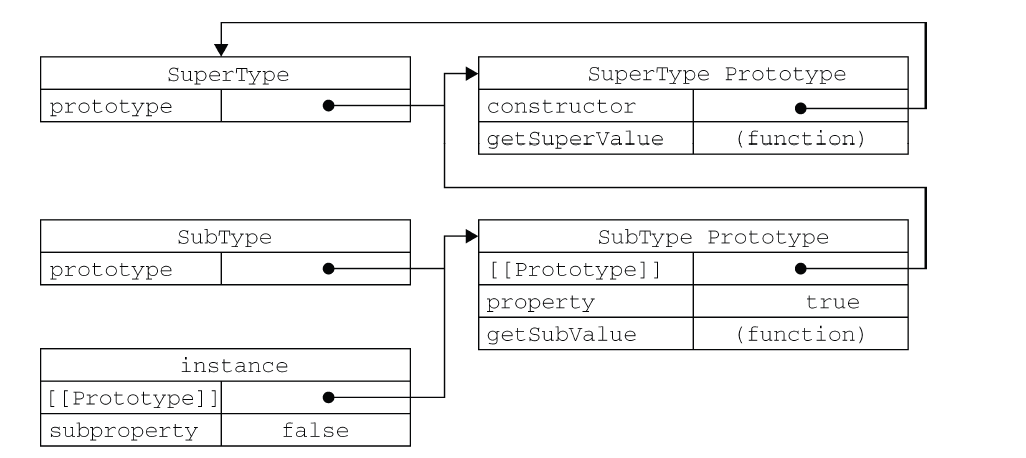ECMAScript中有2中属性:数据属性、访问器属性。
数据属性是为了指定某对象的指定key上的一些行为,比如value是否可删除、修改、key可循环遍历等特点。而访问器属性不包含数据值,包含一堆get、set方法(非必须),读取访问对象属性时,采用getter、setter分别实现。
数据属性包括:
- Configurable:表示能否通过delete删除该属性,或者修改重新定义属性,默认false
- Enumerable:表示for-in循环返回属性,默认false
- Writable:表示能否修改属性值,默认false
- Value:包含这个数据的值
一旦把属性定义为不可配置的,就不能再把它变回可配置了:
var person = {}; Object.defineProperty(person,"name",{ configurable:false, value:"admin" }); //直接报错:TypeError: Cannot redefine property: name Object.defineProperty(person,"name",{ configurable:true, value:"test" })
因为这里的"name"属性已经定义为configurable:false,即不可重新修改属性,所以再次修改会报错。
var person = { name:"我是没修改前的值", _age:22 }; Object.defineProperty(person,"age",{ get:function(){ return this._age; }, set:function(newValue){ if(newValue > this.age){ this._age = newValue; this.name += " 哈哈,我是修改后的name值"; } } }); person.age = 22; console.log(person); person.age = 23; console.log(person);
执行结果:

注意:这里的属性下划线是一种记号,表示只能通过对象方法访问的属性,这样一来,对该属性的读取会使用get、set来实现,如果只指定get表示不能写入,只指定set表示不能读取。
那么,如何一次性声明定义多个属性呢,可以使用Object的defineProperties方法,如下:
var person = {}; Objetc.defineProperties(person,{ _name:{ value:"chaozhou" }, age:{ value:23, set:function(newValue){ this.age = newValue; }, get:function(){ return this.age; } }, sex:{ value:"男" } });
关于对象创建(设计模式)
1、工厂模式
function createPerson(name,age){ var o = new Object(); o.name = name; o.age = age; o.sayName = function(){ console.log(this.name); } return o; } var p = new createPerson("admin",23); p.sayName(); //"admin"
2、构造器模式
function Person(name,age){ this.name = name; this.age = age; this.sayName = function(){ console.log(this.name); } } var p = new Person("admin",23); p.sayName(); //"admin" console.log(p instanceof Object); //true console.log(p instanceof Person); //true function Person2(name,age){ this.name = name; this.age = age; this.sayName = sayname; } function sayname(){ console.log(this.name); } var p2 = new Person2("admin2",22); p2.sayName(); //"admin2" console.log(p2 instanceof Object); //true console.log(p2 instanceof Person2); //true
3、原型模式
function Person(){ Person.prototype.name = "admin"; Person.prototype.age = 12; Person.prototype.sayName = function(){ console.log(Person.prototype.name); }; } var p1 = new Person(); p1.sayName(); //"admin" function Person2(){} Person2.prototype.name = "admin1"; Person2.prototype.age = 14; Person2.prototype.sayName = function(){ console.log(Person2.prototype.name); }; var p1 = new Person2(); p1.sayName(); //"admin1"
原型模式下,所有对象实例共享prototype定义的属性和方法,相当于直接将这些信息添加到原型中。原型设计中的关系如下图(摘自:“javascript高级程序设计”):

自我理解与解释:创建Person构造函数后,Person默认拥有prototype属性,指向的是Person的原型,而Person的原型默认拥有constructor属性,该属性指向一个包含了prototype属性的函数的指针,即Person构造函数,Person原型中的其它属性比如name,是在Person原型属性之上添加的其它属性。person1、person2实例的prototype属性同是一个指向Person.prototype的指针。
判断对象是否是某原型:
Person.prototype.isPrototypeOf(person1) //判断person1内部是否含所有指向Person.prototype的指针
获取某对象的原型:
alert(Object.getPrototypeOf(person1) == Person.prototype); //true
使用delete操作符只能删除实例对象上的属性,不能删除原型上的同名属性:
首先看不使用delete时:
function Person2(){} Person2.prototype.name = "我是原型的name"; Person2.prototype.age = 14; Person2.prototype.sayName = function(){ console.log(Person2.prototype.name); //"我是原型的name" console.log(this.name); //"我是实例的name" }; var p1 = new Person2(); p1.name = "我是实例的name" p1.sayName();
使用delete后:
function Person2(){} Person2.prototype.name = "我是原型的name"; Person2.prototype.age = 14; Person2.prototype.sayName = function(){ console.log(Person2.prototype.name); //"我是原型的name" console.log(this.name); //"我是原型的name" }; var p1 = new Person2(); p1.name = "我是实例的name" delete p1.name; p1.sayName();
判断实例中是否包含某属性hasOwnProperty使用:
function Person2(){} Person2.prototype.name = "我是原型的name"; Person2.prototype.age = 14; Person2.prototype.sayName = function(){ console.log(this.name); //"我是实例的name" }; var p1 = new Person2(); p1.name = "我是实例的name" p1.sayName(); console.log(p1.hasOwnProperty("name")); //true delete p1.name; console.log(p1.hasOwnProperty("name")); //false
相比于hasOwnProperty,in操作符可以判断该实例是否包含该属性,不管该属性存在于实例还是原型中,in可以单独使用,也可以在for-in循环(只能遍历数据属性中Enumerable为true的属性)中使用:
function Person2(){} Person2.prototype.name = "我是原型的name"; Person2.prototype.age = 14; Person2.prototype.sayName = function(){ console.log(this.name); //"我是实例的name" }; var p = new Person2(); var arr = []; for(var attr in p){ arr.push(attr); } console.log(arr); //["name", "age", "sayName"]
使用Object.keys同样可以列出所有对象属性,不同的是对原型使用会返回原型中的所有属性数组,对实例使用仅仅返回实例属性数组:
function Person2(){} Person2.prototype.name = "我是原型的name"; Person2.prototype.age = 14; Person2.prototype.sayName = function(){ console.log(this.name); //"我是实例的name" }; var p = new Person2(); p.test = "admin" console.log(Object.keys(Person2.prototype)); //["name", "age", "sayName"] console.log(Object.keys(p)); //["test"] console.log(Object.getOwnPropertyNames(Person2.prototype)); //["constructor", "name", "age", "sayName"] 获取所有原型属性(不管是否可枚举)
关于原型简写:
可以直接使用如下字面量形式简写:
function Person(){ } //constructor 属性不再指向Person 了,而是指向Object Person.prototype = { name:"admin", age:23, sayName:function(){ console.log(this.name); } }; var p = new Person(); console.log(p instanceof Object); //true console.log(p instanceof Person); //true console.log(p.constructor == Object); //true console.log(p.constructor == Person); //false
简写之后只有一个问题,就是constructor指向变了,可以人为指定constructor指向:
function Person(){ } //constructor 属性不再指向Person 了,而是指向Object Person.prototype = { constructor:Person, name:"admin", age:23, sayName:function(){ console.log(this.name); } }; var p = new Person(); console.log(p instanceof Object); //true console.log(p instanceof Person); //true console.log(p.constructor == Object); //false console.log(p.constructor == Person); //true
原型的动态性
也就说,可以先声明一个实例,然后修改实例原型某属性(如果修改整个原型,则情况有变),则修改后的原型属性或者方法实例可立即调用:
function Person(){ } var p = new Person(); Person.prototype.name = "admin"; console.log(p.name); //"admin"
组合使用构造模式及原型模式
function Person(name,age){ this.name = name; this.age = age; this.friends = ["jefy","lorry"]; } Person.prototype = { constructor:Person, sayName:function(){ console.log(this.name); } } var p1 = new Person("p1",11); var p2 = new Person("p2",22); p1.friends.push("gatu"); console.log(p1.friends); //["jefy", "lorry", "gatu"] console.log(p2.friends); //["jefy", "lorry"] console.log(p1.friends === p2.friends); //false console.log(p1.sayName === p2.sayName); //true
关于对象继承
function SuperType(){ this.property = true; } SuperType.prototype.getSuperValue = function(){ return this.property; }; function SubType(){ this.subproperty = false; } //继承了SuperType SubType.prototype = new SuperType(); SubType.prototype.getSubValue = function (){ return this.subproperty; }; var instance = new SubType(); alert(instance.getSuperValue()); //true alert(instance.getSubValue()); //false
继承实现的本质是重写原型对象,换句话说,原来存在于SuperType 的实例中的所有属性和方法,现在也存在于SubType.prototype 中了。在确立了继承关系之后,我们给SubType.prototype 添加了一个方法,这样就在继承了SuperType 的属性和方法的基础上又添加了一个新方法,结构如下:

我们没有使用SubType 默认提供的原型,而是给它换了一个新原型;这个新原型就是SuperType 的实例。于是,新原型不仅具有作为一个SuperType 的实例所拥有的全部属性和方法,而且其内部还有一个指针,指向了SuperType 的原型。最终结果就是这样的:instance 指向SubType的原型, SubType 的原型又指向SuperType 的原型。getSuperValue() 方法仍然还在SuperType.prototype 中,但property 则位于SubType.prototype 中。这是因为property 是一个实例属性,而getSuperValue()则是一个原型方法。既然SubType.prototype 现在是SuperType的实例,那么property 当然就位于该实例中了。
关于应用类型值的原型问题
先看一个例子:
function SuperType(){ this.colors = ["red", "blue", "green"]; } function SubType(){ } //继承了SuperType SubType.prototype = new SuperType(); var instance1 = new SubType(); instance1.colors.push("black"); alert(instance1.colors); //"red,blue,green,black" var instance2 = new SubType(); alert(instance2.colors); //"red,blue,green,black"
当SubType 通过原型链继承了SuperType 之后,SubType.prototype 就变成了SuperType 的一个实例,因此它也拥有了一个它自己的colors 属性——就跟专门创建了一个SubType.prototype.colors 属性一样。但结果是什么呢?结果是SubType 的所有实例都会共享这一个colors 属性。而我们对instance1.colors 的修改能够通过instance2.colors 反映出来,就已经充分证实了这一点。
如下方式可以解决这个问题:
function SuperType(){ this.colors = ["red", "blue", "green"]; } function SubType(){ //继承了SuperType SuperType.call(this); } var instance1 = new SubType(); instance1.colors.push("black"); alert(instance1.colors); //"red,blue,green,black" var instance2 = new SubType(); alert(instance2.colors); //"red,blue,green"
通过使用call()方法(或apply()方法也可以),我们实际上是在(未来将要)新创建的SubType 实例的环境下调用了SuperType 构造函数。这样一来,就会在新SubType 对象上执行SuperType()函数中定义的所有对象初始化代码。
借用构造函数向超类传递参数:
function SuperType(name){ this.name = name; } function SubType(){ //继承了SuperType,同时还传递了参数 SuperType.call(this, "Nicholas"); //实例属性 this.age = 29; } var instance = new SubType(); alert(instance.name); //"Nicholas"; alert(instance.age); //29
组合继承
function SuperType(name){ this.name = name; this.colors = ["red", "blue", "green"]; } SuperType.prototype.sayName = function(){ alert(this.name);}; function SubType(name, age){ //继承属性 SuperType.call(this, name); this.age = age; } //继承方法 SubType.prototype = new SuperType(); SubType.prototype.constructor = SubType; SubType.prototype.sayAge = function(){ alert(this.age); }; var instance1 = new SubType("Nicholas", 29); instance1.colors.push("black"); alert(instance1.colors); //"red,blue,green,black" instance1.sayName(); //"Nicholas"; instance1.sayAge(); //29 var instance2 = new SubType("Greg", 27); alert(instance2.colors); //"red,blue,green" instance2.sayName(); //"Greg"; instance2.sayAge(); //27
在这个例子中,SuperType 构造函数定义了两个属性:name 和colors。SuperType 的原型定义了一个方法sayName()。SubType 构造函数在调用SuperType 构造函数时传入了name 参数,紧接着又定义了它自己的属性age。然后,将SuperType 的实例赋值给SubType 的原型,然后又在该新原型上定义了方法sayAge()。这样一来,就可以让两个不同的SubType 实例既分别拥有自己属性——包括colors 属性,又可以使用相同的方法了。